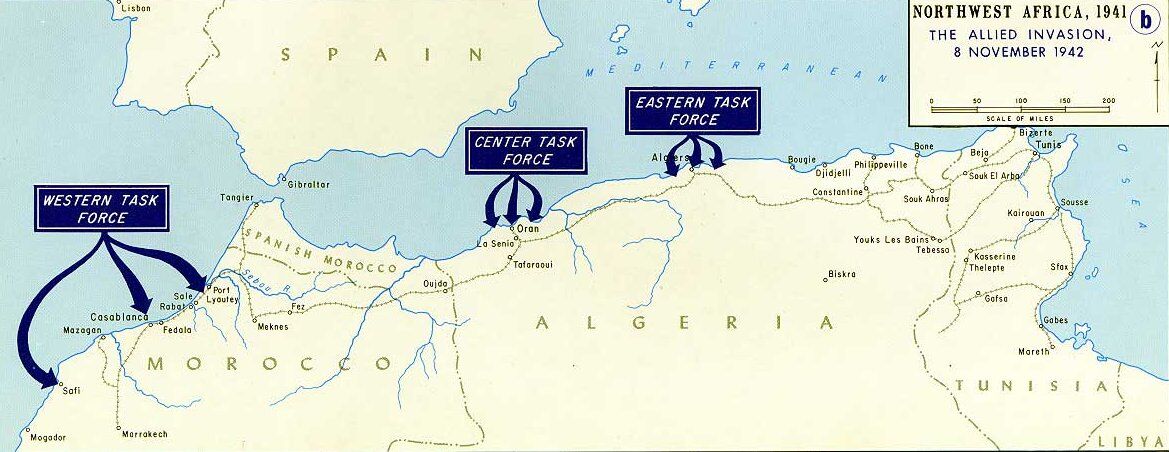The following article on Operation Torch is an excerpt from Barrett Tillman’s book On Wave and Wing: The 100 Year Quest to Perfect the Aircraft Carrier. It is available to order now at Amazon and Barnes & Noble.
Until late 1942 much of northwestern Africa (Tunisia, Algeria, and Morocco) was under control of the Vichy French government, totaling 125,000 soldiers in the territories, along with 210 tanks, 500 aircraft, and coastal artillery. Victory would mean clearing Axis powers from North Africa, reducing German pressure on Russia and improving Allied naval control of the Mediterranean Sea. The British-American invasion plans of French North Africa was known as Operation Torch.
Operation Torch landed on the shores of French Morocco on November 8, 1942, with Ranger (CV-4), Suwanee (ACV-27), Sangamon (ACV26), and Santee (ACV-29) supporting U.S. forces north and south of Casablanca. In all, the four flattops embarked 109 Grumman F4F-4 fighters with sixty-two Douglas SBD-3 and Grumman TBF-1 bombers. Operation Torch was assembled and launched so quickly that many pilots had little opportunity for training. Some had not flown in two weeks—an inordinately long layoff for carrier aviators.
The Casablanca landings were opposed by Vichy French forces allied with Germany. The defenders counted about two hundred aircraft, including American-built Curtiss fighters and Martin bombers.
Things began poorly. On November 8 a flight of seven Santee Wildcats got lost and ran low on fuel. One ditched and five crashlanded ashore with one pilot lost. Ranger’s Fighting Squadron Four lost six planes on its first mission, though Sangamon F4Fs claimed four shootdowns without loss. Later that day eighteen Ranger SBDs attacked harbor facilities including the thirty-five thousand-ton battleship Jean Bart, whose fifteen-inch guns posed a threat to Allied ships. She was partly sunk at her mooring while a submarine was destroyed.
When a French surface force steamed out to engage the U.S. warships, Dauntlesses and Wildcats descended to bomb and strafe. A light cruiser and two destroyers were damaged enough to be run aground to prevent their sinking.
On November 9, Ranger SBDs were back over Casablanca Harbor where Vichy antiaircraft batteries still posed a threat. Dauntlesses hit Jean Bart again, knocking out her remaining AA mounts. Meanwhile, Curtiss P-40s took off from Chenango (ACV-28), flying ashore to newly captured airfields. It was a precursor of other joint ArmyNavy operations throughout the war.
Operation Torch provided a laboratory for carrier aviators to perfect their trade. They flew support missions for ground troops, sank a Vichy submarine at sea, and engaged in air combat. Some of their opponents were combat veterans of the 1939–40 campaign. A Ranger pilot, Lieutenant (jg) Charles A. Shields, bailed out of his riddled F4F, and a Frenchman flying a Hawk buzzed him as he parachuted to earth, “wagging his wingtips and waving and laughing like hell.” Still, the tailhook fighters downed twenty-five Vichymen against five Wildcats lost in dogfights.
Losses were stiff, however, amounting to nearly 25 percent by the time the fighting ended on November 10. Ground fire and operational losses were by far the greatest causes, forcing planners to allot more aircraft to future operations.
Additional Resources About Army Air Corps
Cite This Article
"Operation Torch—A Torch to Vichy France" History on the Net© 2000-2024, Salem Media.
April 17, 2024 <https://www.historyonthenet.com/operation-torch>
More Citation Information.
